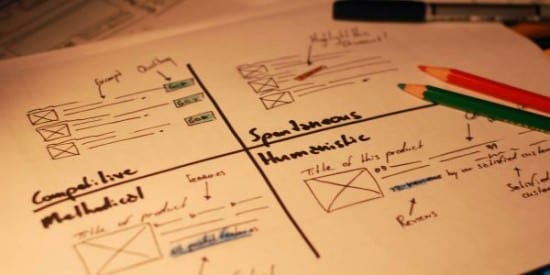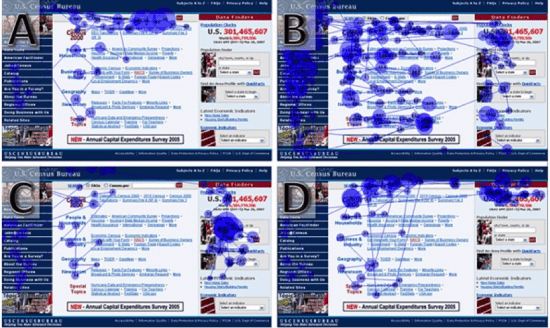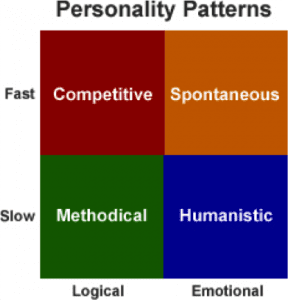Making your emails more relevant by appealing to different reader personalities
In Part 1 we introduced using Personas for Email marketing based upon motivation, in Part 2 I'm going to review the 4 main different personality traits that are common to everyone and show how to apply them to email creative. Aristotle was one of the first to identify them and named them: Melancholic, Phlegmatic, Choleric and Sanguine, however we will be using more descriptive names for these personalities in this post.
By leveraging both personas and personalities, you not only know where to place content, images and set tasks but also know how to speak to them (TOV), what offers to deliver and help them to accomplish their task the way they feel comfortable doing so – thus enabling higher and potentially quicker, conversions.

(Image courtesy of Henk Wijnholds)
Based on the well-known Myers-Briggs approach, there are four primary personas: Competitive (Choleric), Spontaneous (Sanguine), Methodical (Melancholic), and Humanistic (Phelgmatic). Bryan Eisenberg has popularised these for applying to web design using personas, but the approach can be applied to email marketing too.
Depending upon which type of personality is the dominant one within a person will determine how they interact with your emails, as each personality looks for different things, asks specific questions, and resonates with certain words and processes.
Back in 2007 Jakob Nielsen performed a study and found there to be 4 different approaches to how people used the web, which tie in beautifully with these 4 personality types.:
- A: Search Dominant (Competitive)
- B: Navigation Dominant (Methodical)
- C: Tool Dominant (Spontaneous)
- D: Successful (Humanistic)

How can we use this information?
By anticipating their questions, you can write your content for your emails, and motivate them to take action based upon what resonates with them.
Generally speaking we can bundle the 4 personalities into fast/slow and logical/emotional. To do this will help you to understand what type of content, imagery and wording should be placed where within the email in order to relate to how they read the email. (Image courtesy of The Website Architects)

Let’s look at the 4 Personalities in detail and see how we can use this information.
In Waiting for your Cat to Bark, Bryan & Jeffrey Eisenberg compiled a list of questions that each type leads with that reflect their information priorities:
Competitive: Fast & Logical.
Competitive buyers want to perform smart, quick, and decisive actions as a competitive advantage. They are curious and want to see all their options. They're frustrated by inefficiency and wants products and services to help him be more effective. They are the hardest to sell to out of the 4 personalities.
The Competitive focuses on WHAT-type questions:
- What are your competitive advantages?
- What makes you the superior choice?
- What makes you a credible company?
- What can you do to help make me look cutting edge?
- What are your credentials?
- What can you do to help me achieve my goals?
How to sell to them:
- Let them know how your service helps them get ahead.
- Frame your service/product as a competitive advantage
- They abandon pages & carts easily – so implement follow up remarketing emails
- Provide them with upfront, honest information.
What to provide for them:
- Offer a competitor comparison chart – they’ll love it
- Show them how they will save money
- Eye-catching lozenges with “Save £££”
- A quick route to success. They are impatient and don’t scroll but will make a quick decision
- Establish credibility by offering obvious information that is often left unsaid
Spontaneous: Fast & Emotional.
Spontaneous buyers enjoy the thrill of a quick purchase and the perceived emotional benefit that it will generate. They love new items. They're motivated by immediate gratification, and it is important to demonstrate excellent customer service - even after a sale. They don't care about what the competition is offering - if your product is interesting, it will be bought. They fit the description as being an ‘Impulse Buyer’.
The Spontaneous focuses on WHY- and sometimes WHEN-type questions:
- How can you get me to what I need quickly?
- Do you offer superior service?
- Can I customise your product or service?
- Can you help me narrow down my choices?
- How quickly can I take action and achieve my goals?
- Why will this let me enjoy life more?
How to sell to them:
- Create excitement
- Leave out the details. This type lives for the big picture and is bored by detail. They tend to skim, not read.
- Be immediately compelling. Spontaneous users act quickly but lose interest even faster.
- Have a quick and easy process for them to complete. The harder it is the less likely they will complete the task.
What to provide for them:
- “New”, “Just arrived”, “Just released”, “Top Sellers”, “You may also like”
- Place CTA’s above the fold (they don’t scroll)
- Large appealing images
Methodical: Slow & Logical.
Methodical buyers review all technical information to assure themselves that they’re making the right choice. They don’t feel comfortable making a decision until all the facts are available and will soak up everything on the email. They are problem solvers and are very detail oriented. They're willing to scroll to the bottom and read all necessary detail, but they want all facts backed up and are the most likely out of the 4 types to read the fine print.
The Methodical focuses on HOW-type questions:
- What are the details?
- What's the fine print?
- How does this work?
- How can I plan ahead?
- What proof do you have?
- Can you guarantee that?
How to sell to them:
- Methodicals place the value of facts above all else – so provide lots of them.
What to provide for them:
- Statistical & factual information
- and lots of it
- They prefer features to benefits.
- Lots of links so they can find out all the necessary answers online
- Use of graphs and tables impress a Methodical
Humanistic: Slow & Emotional.
Humanistic buyers are motivated by emotion, but want to understand more about the organisation they’re buying from, the individuals who comprise the organisation as well as fellow customers. They fear separation and want to be accepted; therefore, they don't want to choose something that is not supported by a community. They’re very slow to commit and don’t like to feel ‘locked in’. However, once you’ve proven you’re trustworthy, they can be very loyal and are repeat buyers. They deliberate before making their decision and most likely won’t act upon the email immediately.
The Humanistic focuses on WHO-type questions:
- How will your product or service make me feel?
- Who uses your products/service?
- Who are you? Tell me who is on your staff, and let me see bios
- What will it feel like to work with you?
- What experience have others had with you?
- Can I trust you?
- What are your values?
How to sell to them:
- Make them feel safe and secure
- Let them know others like your product/services
- Emphasise trust
- A personal tone resonates well with them.
What to provide for them:
- Testimonials and Case studies
- Lists of client logos and 3rd party secure payment logos
- Access to forums or a community
- Reassure them with money back guarantees, links to return policies and assurances of security
So, whilst we’re not wanting to restrict people or put them into buckets as often we will have different personalities depending upon whether we’re at work or at home, if we understand how these personalities work and are able to provide a little something - call-to-action or content - for each type within our emails, then we will hopefully resonate with all of the personalities and be rewarded with increased conversions.









